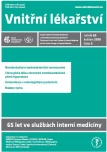-
Medical journals
- Career
Communication with cancer patient
Authors: Jana Halámková 1,2; Ondřej Sláma 1; Dagmar Adámková Krákorová 1; Regina Demlová 3,4; Josef Kuře 2
Authors‘ workplace: Klinika komplexní onkologické péče LF MU a MOÚ, Brno 1; Ústav lékařské etiky LF MU, Brno 2; Farmakologický ústav LF MU, Brno 3; Oddělení klinických hodnocení MOÚ, Brno 4
Published in: Vnitř Lék 2019; 65(5): 359-362
Category:
Overview
The oncological patients meet the diverse physicians in the different stages of their illness. It is important for other physicians to know a basic rules of supportive effective communication. There are big differences between patients in the communication style and type of information they accept. Patient´s information requirements may also change at various stages of the disease. Providing bad news is a frequent and important communication challenge for physicians. Internationally recognized and proven recommendation for communication is the six steps known as the SPIKES. Prolonging survival of cancer patients means not only communicating disease information but also information about irreversible and potentially irreversible side effects of treatment, disease complications, and limited prognosis. The communication skills are not inborn and do not necessarily improve with the clinical experience, this skill should be learned through structured communication training. It’s the effective communication that lets talk sensitively about serious facts in the time-limited consultation.
Keywords:
communication – oncology patient – SPIKES
Sources
- Mitchell JL. Cross-cultural issues in the disclosure of cancer. Cancer Pract 1998; 6(3): 153–160.
- Ong LM, Visser MR, Lammes FB et al. Doctor-patient communication and cancer patients‘ quality of life and satisfaction. Patient Educ Couns 2000; 41(2): 145–156.
- Butow PN, Maclean M, Dunn SM et al. The dynamics of change: cancer patients‘ preferences for information, involvement and support. Ann Oncol 1997; 8(9): 857–863.
- Jenkins V, Fallowfield L, Saul J. Information needs of patients with cancer: results from a large study in UK cancer centres. Br J Cancer 2001; 84(1): 48–51. Dostupné z DOI: <http://dx.doi.org/10.1054/bjoc.2000.1573>.
- Bommier C, Mamzer MF, Desmarchelier D et al. How nonverbal communication shapes the doctor-patient relationship: from paternalism to the ethics of care in oncology. J Int Bioethique 2013; 24(4): 137–158.
- Vorlíček J, Sláma O, Kalvodová L. Sdělování onkologické diagnózy. Vnitř Lék 2001; 47(8): 544–547.
- Baile WF, Buckman R, Lenzi R et al. SPIKES-A six-step protocol for delivering bad news: application to the patient with cancer. Oncologist 2000; 5(4): 302–311.
- Mead N, Bower P. Patient-centredness: a conceptual framework and review of the empirical literature. Soc Sci Med 2000; 51(7): 1087–1110.
- Buckman R. Communications and emotions. BMJ 2002; 325(7366): 672.
- Wallace JA, Hlubocky FJ, Daugherty CK. Emotional responses of oncologists when disclosing prognostic information to patients with terminal disease: results of qualitative data from a mailed survey to ASCO members. J Clin Oncol 2006; 24(Suppl 18): 8520. Dostupné z DOI: <http://dx.doi.org/10.1200/jco.2006.24.18_suppl.8520>.
- Maguire P. Improving communication with cancer patients. Eur J Cancer 1999; 35(10): 1415–1422.
- Schapira L. Communication skills training in clinical oncology: the ASCO position reviewed and an optimistic personal perspective. Crit Rev Oncol Hematol 2003; 46(1): 25–31.
Labels
Diabetology Endocrinology Internal medicine
Article was published inInternal Medicine

2019 Issue 5-
All articles in this issue
- Limited ambulatory night sleep testing in patients with a suspicion of sleep apnoea syndrome: Is its indication tenable?
- Surgical treatment of chronic thromboembolic pulmonary hypertension
- Communication with cancer patient
- Multimodal treatment of thymic carcinoid: a case report
- Nontuberculous mycobacterial disease: a case report-based review
- Use of idarucizumab in clinical practice: a case report
- Otto Kahler and his family: II. Ripening years in Prague
- Compliance with ethical rules for scientific publishing in biomedical Open Access journals indexed in Journal Citation Reports
- Internal Medicine
- Journal archive
- Current issue
- Online only
- About the journal
Most read in this issue- Communication with cancer patient
- Surgical treatment of chronic thromboembolic pulmonary hypertension
- Limited ambulatory night sleep testing in patients with a suspicion of sleep apnoea syndrome: Is its indication tenable?
- Nontuberculous mycobacterial disease: a case report-based review
Login#ADS_BOTTOM_SCRIPTS#Forgotten passwordEnter the email address that you registered with. We will send you instructions on how to set a new password.
- Career

